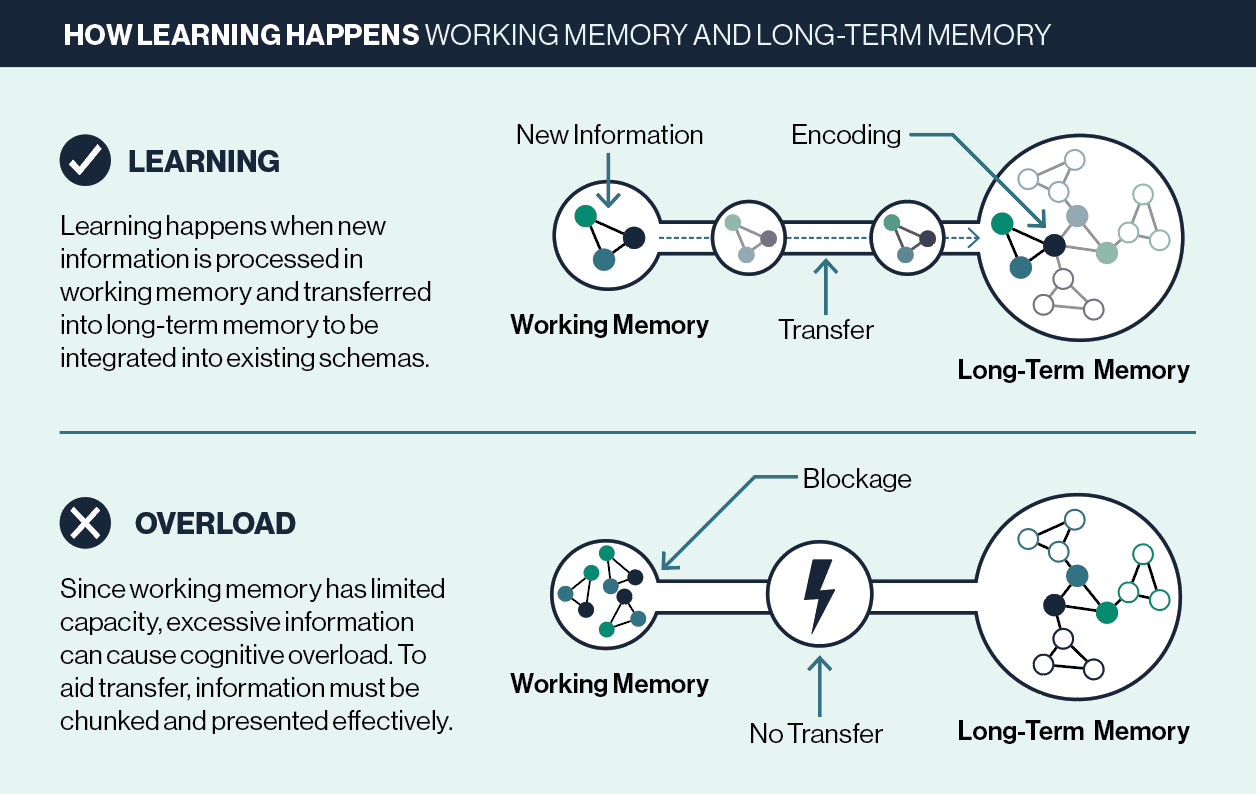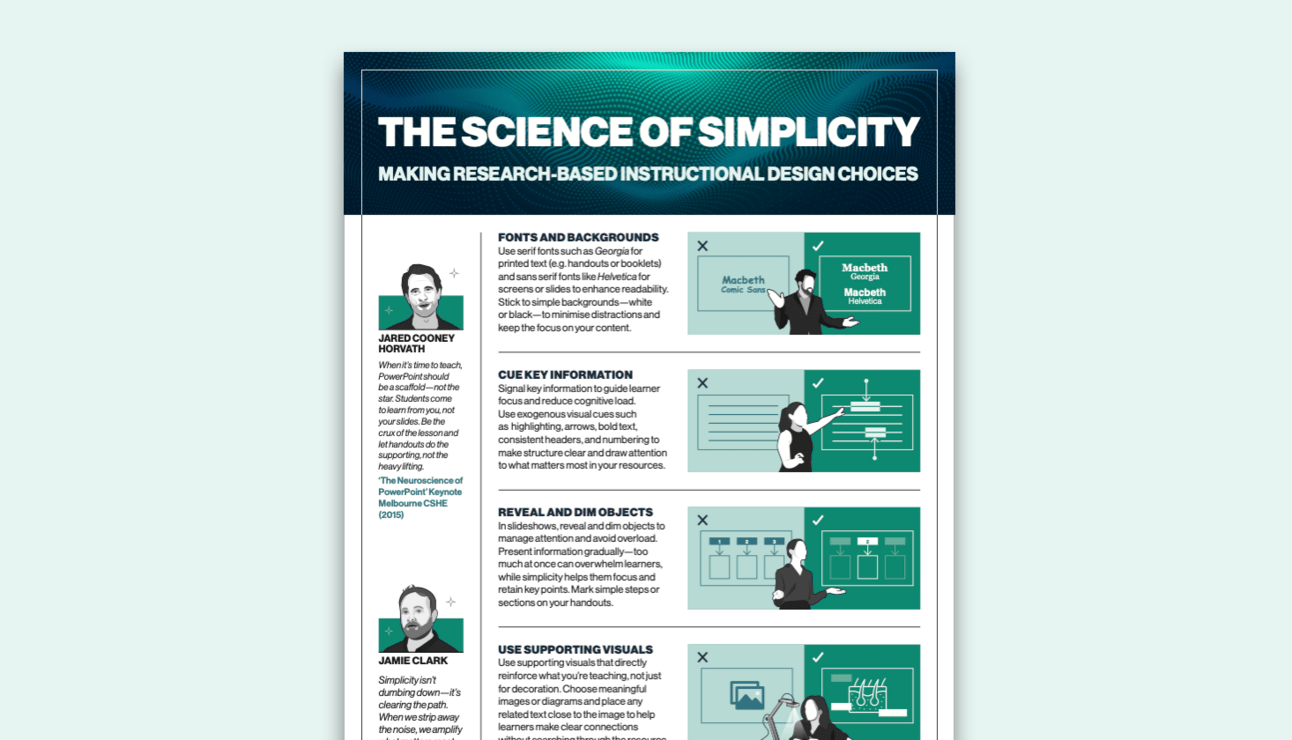👋 Greetings {{first name | there}}!
In this edition of ⚗️DistillED, we explore how teachers can apply Cognitive Load Theory principles to improve instructional materials.
Whether you’re building a slide deck, designing a worksheet, or explaining a new concept, keeping it simple and optimising your communication matters.

What is meant by optimising communication?
Optimising communication means designing instruction in a way that reduces unnecessary cognitive load and makes learning clearer and more accessible.
Poorly designed lessons can unintentionally overload students—especially when content is cluttered, fleeting, or split across multiple sources. The three most common instructional design traps that overwhelm students are:
Coherence Effect* (Redundancy Effect) = Too much unnecessary stuff
E.g. A History teacher clutters slides with decorative images and walls of text, distracting from the key message.
Transient Information Effect = Stuff that disappears too quickly.
E.g. A Maths teacher solves a complex problem on the board but erases it (or moves the slide forward) before students have processed the steps.
Split-Attention Effect = Too many things to focus on
E.g. A Science teacher talks through a diagram, but the explanation is separate from the visual, forcing students to mentally integrate them.
*NOTE Coherence Effect is from Richard E. Mayer’s work on Multimedia Learning - Sweller refers to this same effect more broadly as The Redundancy Effect
Why does optimising communication matter?
John Sweller’s Cognitive Load Theory is a research-backed framework that helps teachers design materials in ways that reduce cognitive overload and make learning more efficient. It’s grounded in the core idea about learning which is captured neatly here by Kirschner, Sweller and Clark:
“The aim of all instruction is to alter long-term memory. If nothing has changed in long-term memory, nothing has been learned.”
Working memory is severely limited. We can only deal with about seven chunks of information at any given time. If we overload working memory with too much information at once, learning can bottle-neck and stall. Here’s a quick overview showing how learning typically happens and how easily working memory can be overloaded.

Cognitive Load Theory highlights the importance of balancing two types of mental load:
Intrinsic load – the complexity of the content itself
Extraneous load – the unnecessary mental effort caused by poor instructional design
Extraneous load comes from things like cluttered slides, vague instructions, or irrelevant details. These distractions consume working memory and make it harder for students to focus on the core content.
Effective teachers reduce extraneous load by optimising communication—presenting material clearly and simply to support student thinking. In short, when we communicate clearly, students have the mental space to think and subsequently transfer information into long-term memory.
How do I apply CLT to instructional design?
Let’s focus on each one in a bit more detail and explore some practical solutions to help optimise communication during your classroom instruction:
Effect | Explanation | Solution |
|---|---|---|
The Coherence Effect Note: Sweller refers to this same effect more broadly as The Redundancy Effect | Occurs when extraneous, irrelevant, or decorative information is included, distracting from the core content. | Cut the Clutter! Edit long text into concise bullet points or timelines for clarity Break content into sections or spread it across multiple slides. Remove distracting or decorative visuals. |
The Transient Information Effect | Occurs when key information is presented briefly and then disappears, making it harder for students to retain and process. | Keep Key Info Visible! Provide handouts with summaries or steps for key information. Consistently structure content clearly into sections or boxes. Use navigation aids such as tabs, cues or headings. |
The Split Attention Effect | Occurs when students must divide their attention between multiple sources of information that need to be mentally integrated. | Keep it Together! Integrate labels directly into diagrams. Provide summaries to capture all required information on one page. Use spoken explanations instead of written text with visuals. |
What does this look like you ask? The following examples below help to visualise what these solutions look like in action:
Cut the Clutter!
This teacher uses:
Bullet points
Concise sentences
Headings
Gradually revealed information

Information slide from a secondary History teacher
Keep Information Visible!
This teacher uses:
Side panel for previous steps
Navigation tabs
Fading of previous steps
Gradually revealed information

Worked example from a primary Maths teacher
Keep it Together!
This teacher uses:
Integrated labels on diagram
Verbal explanations
Gradually revealed information

Diagram from a secondary Science teacher
Where can I find out more?
One-Page A3 Guide
This free guide unpacks three powerful effects from Cognitive Load Theory—Coherence, Transient Information, and Split Attention—and shows how to beat them with better instructional design.

One-Page A4 Design Guide
Use this one-pager to design lessons and resources that are focused, effective, and student-friendly—all grounded in evidence-informed principles.

Until next time — stay curious, stay clear!
Jamie
📻 Teachers Talk Radio
Teachers Talk Radio brings the voices of teachers straight to your ears. Tune in for daily shows hosted by real teachers, tackling classroom challenges, pedagogy, policy changes, and everything in between.
Whether you're commuting, marking books, or just winding down, you'll find thoughtful debate, practical tips, and honest conversations.
Enjoy DistillED? Here's another fantastic weekly newsletter to add to your inbox — Soundbites and Insights from TTR. Stay informed and never miss a moment with curated highlights from the week's standout shows.
News you’re not getting—until now
Join 4M+ professionals who start their day with Morning Brew—the free newsletter that makes business news quick, clear, and actually enjoyable.
Each morning, it breaks down the biggest stories in business, tech, and finance with a touch of wit to keep things smart and interesting.


